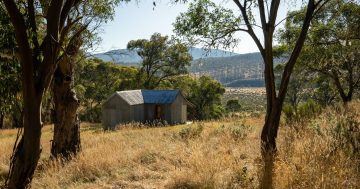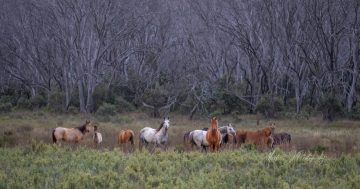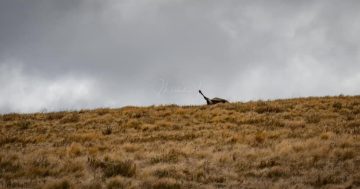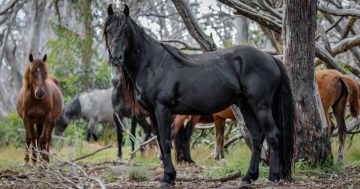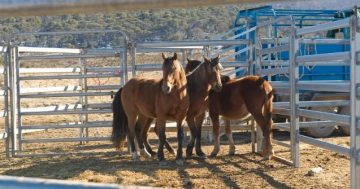
One of the foals found in the southern end of Kosciuszko National Park at the weekend. Image: Shannon Byrne.
Update October 31, 11:00 am: The second foal found in KNP on Saturday by Shannon Byrne died early this morning.
A man who discovered two starving foals in Kosciuszko National Park says he is under no illusion the NSW Government is to blame.
On Saturday (28 October), local Shannon Byrne carried a weak foal 500 metres to a waiting car in a bid to save its life, while another foal followed behind.
Both colts, just under a week in age, had been discovered alone in the dense bushland south of Jindabyne by Mr Byrne as he was riding that morning.
Video footage of the foals widely shared on social media has resulted in an explosive reaction from animal welfare advocates.
“If it was one foal, I guess there’s a number of scenarios that could have occurred,” Mr Byrne said. “But to find two foals together like that just points to foul play, I wonder if there’s been an illegal cull but the fact is, it’s come to this.”
He, like other park users, has encountered countless orphans in recent months, some wandering into camps in search of food.
In the wake of NSW Environment Minister Penny Sharpe’s announcement that aerial shooting of feral horses will be permitted in Kosciuszko National Park, concerns have raged in the social media court of opinion those operations were already underway, despite categoric denials.
Mr Byrne is still dubious. He said orphaned foals were usually the result of bait and trap operations where mares are lured by feed and become locked in self-closing purpose-built yards.
He is concerned that, with aerial shooting imminent, during foaling season, this is just the start.
“Had I left the poor buggers there they would have been torn apart by wild dogs,” he said. “That’s what happens.”
Delivered into the hands of an experienced local carer, the weakest foal died Saturday night and the other is said to be battling.
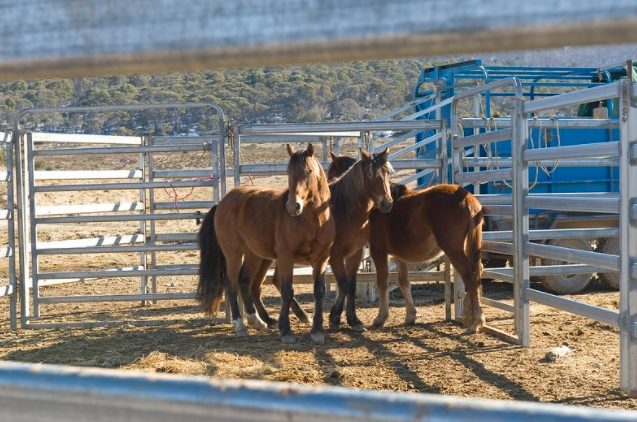
Wild horses in Kosciuszko National Park have been trapped using lures in recent years. This form of culling has resulted in mares being separated from their foals. Photo: File.
Mr Byrne’s great-grandmother was the first white woman to cross the Snowy Mountains and his family have held land there since the 1840s. Having ridden in the mountains two to three times a week for most of his life, this bushman’s knowledge of KNP is second to none.
With generations of his family living side by side with the wild side of the mountains, where corrobboree frogs used to proliferate alongside the thousands of grazing sheep and cattle and wild horses frequently, caught, trained kept or sold, he’s well placed to comment on the issue.
He said he has no time for politics but is damning of the management of the park by NSW National Parks and Wildlife Service (NPWS).
“They behave like a law unto themselves, they will do what they want, they always have here and now it’s got to the point where it’s out of control,” Mr Byrne said.
And by out of control, he says wild horses are the least of their problems.
On Saturday’s four-hour ride, Mr Byrne says he encountered four colts.
“Here it’s rough and there’s a natural attrition that takes care of the horses but even in the north of the park, there’s nowhere near the numbers like they’re saying, you’d be lucky if you found 1000 horses up there now.”
He also sees the weeds, bogged waterways caused by hundreds of deer, pig rippings and 20 years of unfettered, unmanaged grasslands that now render some parts of the park a tinderbox.
“Look at the Corroboree Frog, years and years of grass laying over forming a mat creating an intolerable humid acidic environment and frogs with a fungal disease they’re blaming on climate change,” Mr Byrne said.
“It’s catastrophic up here right now, and the NPWS are killing what they’re claiming to save, they say in the 2019-20 Dunns Fire 15 billion native animals were lost.
“The horses have been there their whole lives and didn’t cause the extinction of those animals but a fire will come along and wipe them out overnight.”
“It’s not the brumbies that are destroying this park. We’ve all lived up here in harmony for the best part of 150 years, but the NPWS have a lot to answer for in terms of what is happening up here,” Mr Byrne added.
“If we took the horses out, they’re still going to have 90 per cent of the environmental damage.”
Aerial culling, he says, isn’t the answer.
“I’m all for management but … shooting’s not right. I’ve seen deer littered with bullet holes, others who didn’t die instantly laying on the ground thrashing for days.
“There’s nothing humane about it, [NPWS] like to sugarcoat it and say one shot kills but one shot doesn’t kill.”
He says local people with generations of experience should be put back in charge of the park.
“Parks, politicians, conservationists, they can’t ride around and read the land like bushmen do.
“To see this situation time and time again – poor defenceless creatures left at the mercy of the bush – and knowing there will be more of it, I don’t care what anyone says, it’s inhumane.”
A NPWS spokesperson said aerial shooting, approved by the NSW Government on Friday, had yet not commenced within Kosciuszko National Park.
In relation to the discovery of the foals, the spokesperson said: “There was very little information from the social media video to determine its exact location, which indicates to be ‘the southern end’ however the NPWS has not undertaken any horse control operations in southern Kosciuszko National Park since early this year.”
“NPWS has not been provided any specific information regarding this alleged issue. If information is provided, NPWS will investigate”.









